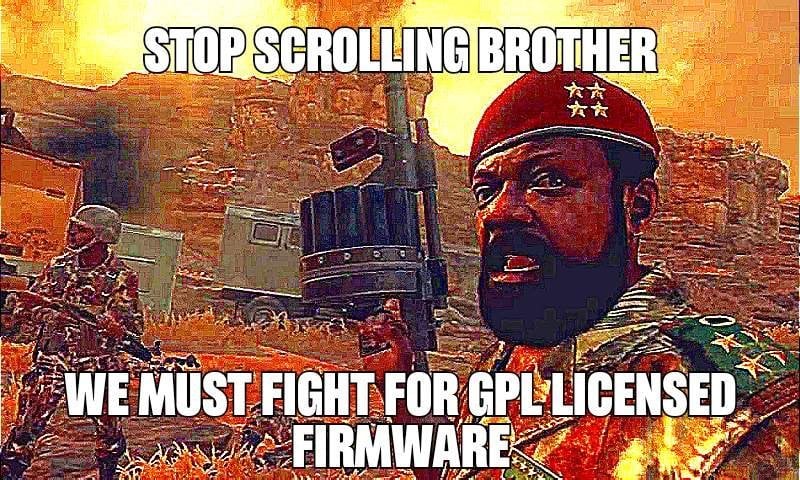this post was submitted on 14 Jan 2024
1126 points (97.4% liked)
linuxmemes
20998 readers
2741 users here now
Hint: :q!
Sister communities:
- LemmyMemes: Memes
- LemmyShitpost: Anything and everything goes.
- RISA: Star Trek memes and shitposts
Community rules (click to expand)
1. Follow the site-wide rules
- Instance-wide TOS: https://legal.lemmy.world/tos/
- Lemmy code of conduct: https://join-lemmy.org/docs/code_of_conduct.html
2. Be civil
- Understand the difference between a joke and an insult.
- Do not harrass or attack members of the community for any reason.
- Leave remarks of "peasantry" to the PCMR community. If you dislike an OS/service/application, attack the thing you dislike, not the individuals who use it. Some people may not have a choice.
- Bigotry will not be tolerated.
- These rules are somewhat loosened when the subject is a public figure. Still, do not attack their person or incite harrassment.
3. Post Linux-related content
- Including Unix and BSD.
- Non-Linux content is acceptable as long as it makes a reference to Linux. For example, the poorly made mockery of
sudoin Windows. - No porn. Even if you watch it on a Linux machine.
4. No recent reposts
- Everybody uses Arch btw, can't quit Vim, and wants to interject for a moment. You can stop now.
Please report posts and comments that break these rules!
founded 1 year ago
MODERATORS
you are viewing a single comment's thread
view the rest of the comments
view the rest of the comments

What's different? Basically the whole thing.
A 3D printer (talking here about FDM because SLA really shares nothing at all with a 2D printer) is basically a tiny hot glue gun being moved on three axies by stepper motors. Of course, the temperature and extrusion controls are much more accurate than a hot glue gun, but that's the basic principle. You got a single "printing point" that gets moved around and it only extrudes filament from that single point.
An inkjet printer has one stepper motor that moves the paper and another that moves the print head from left to right. So there too are axies moved on stepper motors. A very simple trait also shared by e.g. CD and disk drives, slot machines, camera lenses and many other things. All these things are as close to a 2D printer as a 3D printer.
The real magic of an inkjet printer is the print head. A print head doesn't have a single nozzle but an array of many nozzles. This way, a printer cannot only print one dot at a time, but instead a few lines at a time. These nozzles are much tinier that the nozzles on a 3D printer, and they also are much more complicated to operate.
A 3D printer just uses a stepper motor to push filament into the printhead, where it melts and is then pushed out of a hole.
On an inkjet printer, you need to either rapidly boil the ink, so that a single vapor bubble appears that pushes just a tiny drop of ink on the paper, or you have a tiny piezoelectric transducer that creats a vibration that then pushes out ink.
This is orders of magnitude more difficult than a 3D printer, and much tinier. You won't be DIYing a working 2D printer from scratch, while that isn't all that hard for a 3D printer. With access to a decent toolshop, you can make all relevant parts of a 3D printer. The same is not true for 2D printers.
To rephrase your question: Why is it that so many people build DIY desktop PCs, but nobody is making a DIY flagship smartphone? What's the difference?
Basically everything.
Man, your explanation is way better than mine, kudos! :D
TIL inkjet printer is very complicated compared to 3d printer
I always think paper printer is very easy to make (well since so many paper printers out there compared to 3d printers)
Yeah, that's more due to need than due to technical difficulty.
Even in 2024 it's still common that you have to print out documents to sign them or tickets for some event or something like that. All these (quite relevant) use cases just don't work if you don't have a 2D printer.
As much as I like my 3D printer, and as much as I recommend everyone to have one, is not nearly as necessary.
In regards to how difficult they are to make, consider the price.
2D printers have an advantage due to their much higher sales numbers (economy of scale) and they are subsidized by the manufacturer selling expensive ink. And still, a half-decent inkjet costs €100 or more, and a color laser easily costs €300 or more.
3D printers usually have much lower sales numbers and people usually buy 3rd party filament, so the printer needs to be expensive enough to generate money for the manufacturer. And still you can get a decent Ender 3 for as low as €150.